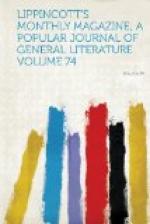power. ‘What is that?’ said King Anang
Pal.—’It is,’ said the Brahman,
’the serpent Sechnaga, who lies under the earth
and stops it, and who at the same time has charge of
Change and Revolution.—’Well, and
what then?’ said King Anang Pal.—’If
the serpent were dead there would be no change,’
said the Brahman.—’Well, and what
then?’ said King Anang Pal.—’If
you should cause to be constructed a great nail of
iron, I will show you a spot where it shall be driven
so as to pierce the head of the serpent.’
It was done; and the nail—being this column
which you now contemplate—was duly driven.
Then the Brahman departed from the court. Soon
the king’s mind began to work, to question,
to doubt, to harass itself with a thousand speculations,
until his curiosity was inflamed to such a degree that
he ordered the nail to be drawn out. With great
trouble and outlay this was done: slowly the
heavy mass rose, while the anxious king regarded it.
At last the lower end came to his view. Rama!
it was covered with blood. ‘Down with it
again!’ cries the joyful king: ‘perhaps
the serpent is not yet dead, and is escaping even now.’
But, alas! it would not remain stable in any position,
pack and shove howsoever they might. Then the
wise Brahman returned. ‘O king,’ said
he, in reply to the monarch’s interrogatories,
’your curiosity has cost you your kingdom:
the serpent has escaped. Nothing in the world
can again give stability to the pillar or to your reign.’
And it was true. Change still lived, and King
Anang Pal, being up, quickly went down. It is
from this pillar that yon same city gets its name.
In the tongue of these people
dilha is, being
interpreted, ‘tottering;’ and hence Dilhi
or Delhi. It must be confessed, however, that
this is not the account which the iron pillar gives
of itself, for the inscription there declares it to
have been erected as a monument of victory by King
Dhara in the year 317, and it is known as the Lath
(or pillar) of Dhara.”
[Illustration: Indigo-factory near
Allahabad.]
Next day we took train for Agra, which might be called
Shah Jehan’s “other city,” for it
was only after building the lovely monument to his
queen—the Taj Mahal—which has
made Agra famous all over the world, that he removed
to Delhi, or that part of it known as Shahjehanabad.
Agra, in fact, first attained its grandeur under Akbar,
and is still known among the natives as Akbarabad.
“But I am all for Shah Jehan,” I said
as, after wandering about the great citadel and palace
at the south of the city, we came out on the bank
of the Jumna and started along the road which runs
by the river to the Taj Mahal. “A prince
in whose reign and under whose direct superintendence
was fostered the style of architecture which produced
that little Mouti Masjid (Pearl Mosque) which we saw
a moment ago—not to speak of the Jammah
Masjid of Delhi which we saw there, or of the Taj
which we are now going to see—must have
been a spacious-souled man, with frank and pure elevations
of temper within him, like that exquisite white marble
superstructure of the Mouti Masjid which rises from
a terrace of rose, as if the glow of crude passion
had thus lifted itself into the pure white of tried
virtue.”




